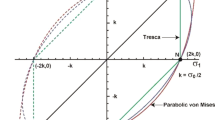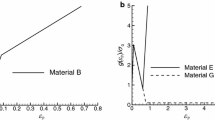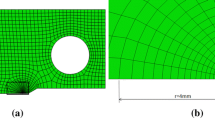Abstract
The paper reports the results from an asymptotic analysis for a crack growing quasistatically under Mode I, plane stress conditions for a power-law hardening material. The asymptotic stress and deformation velocity fields near the growing crack tip are determined, comparisons to related work are discussed and some numerical results for aluminum are included.
Similar content being viewed by others
References
Amazigo, J.C. and Hutchinson, J.W. (1977). Crack tip fields in steady crack-growth with linear hardening. Journal of the Mechanics and Physics of Solids 25, 81–97.
Anderson, H. (1973). Finite element representation of stable crack growth. Journal of the Mechanics and Physics of Solids 21, 337–356.
Bakuckas, J.G. and Newman, J.C. (1993). Prediction of Stable Tearing of 2024-T3 Aluminum Alloy Using the Crack Tip Opening Angle Approach. NASA TM 109023.
Dawicke, D.S. and Sutton, M.A. (1993). Crack Tip Opening Angle Measurements and Crack Tunnelling under Stable Tearing in Thin Sheet 2024-T3 Aluminum Alloy. NASA CR 191523.
Dawicke, D.S. and Sutton, M.A. (1994). CTOA and crack tunnelling measurements in thin sheet 2024-T3 aluminum alloy. Experimental Mechanics 34, 357–368.
Dawicke, D.S., Newman, J.C., Sutton, M.A. and Amstutz, B.E. (1994). Influence of crack history on the stable tearing behaviour of a thin-sheet material with multiple cracks. FAA/NASA International Symposium of Advanced Structure Methods and Airframe Durability. NASA Conference Publications 3274(1), 193–212.
Deng, X. and Rosakis, A.J. (1992). A finite element investigation of quasi-static and dynamic asymptotic crack tip fields in hardening elastic-plastic solids under plane stress, Part 2: Crack growth in power-law hardening materials. International Journal of Fracture 58, 137–158.
deKoning, A.U. (1977). A contribution to the analysis of quasi-static crack growth in steel materials. Proceedings of the Fourth International Conference on Fracture 3, 25–31.
Gang, H., Sutton, M.A. and Chao, Y.J. (1995). A study of stable crack growth in thin SEC specimens of 304 stainless steel by computer vision. Engineering Fracture Mechanics 52, 525–555.
Gao, Y.C. (1987). Plane stress dynamic plastic field near a propagation crack tip. International Journal of Fracture 34, 111–129.
Harris, C.E. (1992). NASA Airframe Structural Integrity Program, NASA TM 102637.
Hutchinson, J.W. (1968). Plastic stress and strain fields at a crack tip. Journal of the Mechanics and Physics of Solids 16, 337–347.
Hutchinson, J.W. (1983). Crack-tip singularity fields in nonlinear fracture mechanics: A survey of current status. Advances in Fracture Research (Edited by D. Francois), Vol. 6, ICF5, Cannes, France, 2669–2684.
Kanninen, M.F. (1980). The analysis of stable crack growth in type 304 stainless steel. Proceedings of International Conference on Fracture, 1759–1768.
Kanninen, M.F. and Popelar, C. (1985). Advanced Fracture Mechanics, Cambridge University Press, Cambridge.
Maclin, J.R. (1992). Performance of fuselege pressure structure. International Conference on Aging Aircraft and Structural Air Worthiness. NASA Langley Research Center, 67–74.
Narasimhan, R., Rosakis, A.J. and Hall, J.F. (1987). A finite element study of stable crack growth under plane stress condition. Journal of Applied Mechanics 59, 846–853.
Newman, J.C., Dawick, D.S. and Bigelow, C.A. (1992). Finite Element Analysis and Fracture Simulation in Thin-Cheet Aluminum Alloys. NASA TM 107662.
Pan, H. (1987). The asymptotic analysis of near crack tip fields for a plane stress mode I crack growing quasistatically in power-law hardening materials. Proceedings of International Conference of Fracture and Fracture Mechanics, Shanghai, China, 300–303.
Pan, H. (1988). Investigations of cracks growing steadily in power-law hardening solids. Acta Mechanica Sinica (in Chinese) 20, 142–153.
Rice, J.R. (1973). Mechanics and Mechanisms of Crack Growth. (Edited by M.T. May), British Steel Corporation, Physics and Metal. Centre Publishers, Sheffield, 14–39.
Rice, J.R. (1982). Mechanics of Solids, R. Hill's 60th Anniversary Volume 1, (Edited by Hopkins et al.), Pergamon Press, New York, 539–551.
Wang, W.X. and Fan, T.Y. (1994). Analytic solution of mode I crack in materials with nonlinear behaviour. Philosophical Magazine Letters 59, 215–222.
Wells, A.A. (1961). Unstable crack propagation in materials: cleavage and fast fracture. Proceedings of the Cranfield Crack Propagation Symposium, 210–230.
Wells, A.A. (1963). Application of fracture mechanics at and beyond general yielding. British Welding Journal 11, 563–570.
Wu, X.F. and Fan, T.Y. (1997). Finite element analysis on plane stress crack growth of power-low hardening material. Journal of Beijing Institute of Technology 6(4) (in press).
Author information
Authors and Affiliations
Rights and permissions
About this article
Cite this article
Fan, T., Sutton, M. & Zhang, L. Plane Stress Steady Crack Growth in a Power-Law Hardening Material. International Journal of Fracture 86, 327–341 (1997). https://doi.org/10.1023/A:1007410614342
Issue Date:
DOI: https://doi.org/10.1023/A:1007410614342




